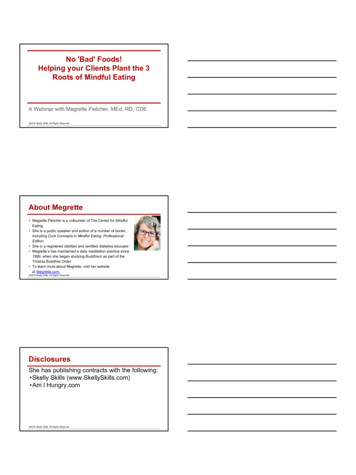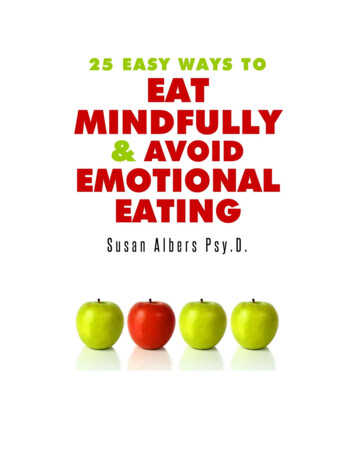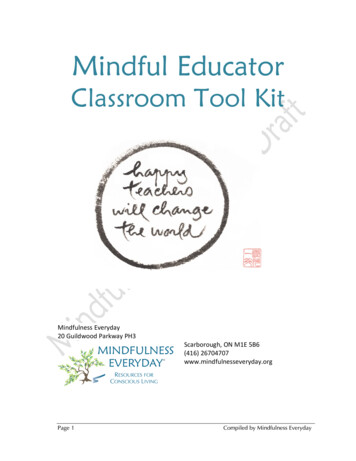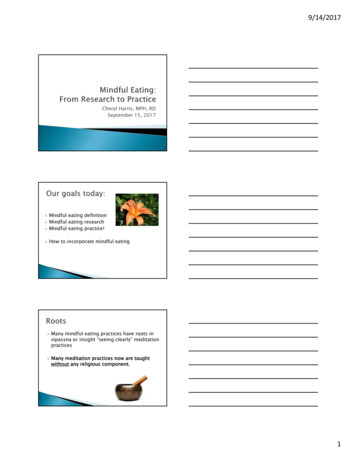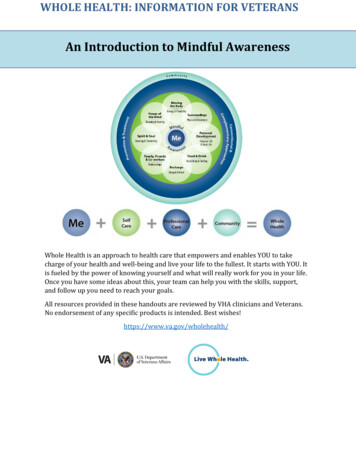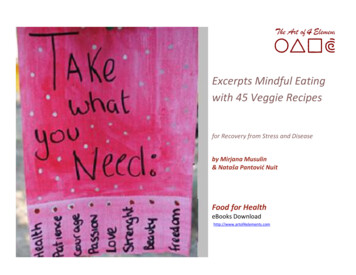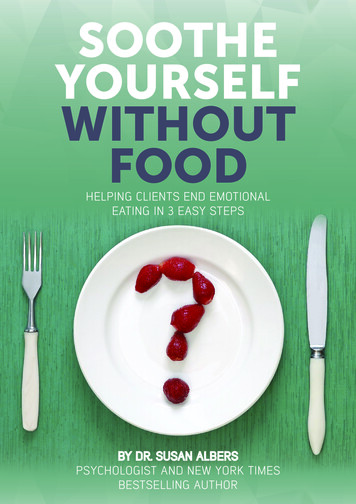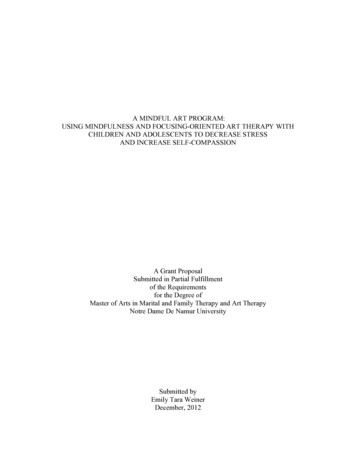
Transcription
WHOLE HEALTH: INFORMATION FOR VETERANSMindful EatingWhole Health is an approach to health care that empowers and enables YOU to takecharge of your health and well-being and live your life to the fullest. It starts with YOU. Itis fueled by the power of knowing yourself and what will really work for you in your life.Once you have some ideas about this, your team can help you with the skills, support,and follow up you need to reach your goals.All resources provided in these handouts are reviewed by VHA clinicians and Veterans.No endorsement of any specific products is intended. Best wishes!https://www.va.gov/wholehealth/
Mindful EatingMindful EatingWhat is mindful eating?Eating mindfully means being aware of every bite we eat to taste more and eat less.1 Whilewe are eating, most of us are thinking about what we need to do tomorrow, what happenedyesterday, or what channel to watch on television. When we “stay in the moment” andfocus our attention on the food we eat, we can do the following: cut down on portions avoid stress eating realize when we feel full stop eating when we aren’t hungry2How can eating mindfully help me?There are many reasons to include mindful eating in a Personal Health Plan (PHP). Forexample: It can lead to positive and lasting change. Food becomes something to enjoy, instead of a temptation or regret.3 Mindful eating slows down the pace of your meals. Your brain will then have time tohear the “I’m full” signals from your stomach. This may help with maintaining ahealthy weight. It aids in digesting food. Research has found that when we do not focus on oureating, we do not digest our food as well. This can lead to gas, bloating, anddiscomfort.4 Mindfulness can help you pay attention to where your food comes from. This mighthelp you buy healthier foods, including local and/or organic options.How does the brain respond to unhealthy foods?A little later, we’ll discuss ways that you can pay more attention to what you eat. Before wedo that, it is important to understand how your emotions affect the way you eat. And you’lllearn how the way you eat changes the chemical makeup in your brain.Your brain rewards you by releasing hormones like dopamine and adrenaline when you eathigh-fat and high-sugar meals. In this way, your brain reacts the same way to unhealthyfoods as it would to drugs like alcohol and heroin.5 And just like with drugs, you canbecome addicted to unhealthy foods over time. You then crave unhealthy foods and eatmore food overall to satisfy these cravings. Over time, more changes happen in your brain,and you can become less thoughtful about the foods you eat as a result.When you are feeling more stress in your life, or feeling down or depressed, your bodyreleases the “stress hormone,” also known as cortisol. This hormone again increasesyour cravings for unhealthy foods and decreases your ability to resist these foods. Ifyou experience a lot of stress over time, your brain reacts by continuing the cravings. Itthen becomes even harder to make healthy food choices. 6Page 2 of 7
Mindful EatingThere are many more hormones that are released by the body and the brain because ofstress and the foods that you eat. We will not be discussing these in this handout. However,it is worth knowing just how important your outside environment is to the healthy andunhealthy decisions you make about food. In fact, studies have even shown that justlooking at sugary foods triggers our bodies to release hormones that convert more energyinto fat. 7How can I learn to eat mindfully at home?There are many ways to experience mindful eating. One way that works very well involvesa single grape and just five minutes of your time.8 You can also do this practice with anyfood you are eating. See the next page for a mindful eating exercise.Page 3 of 7
Mindful Eating ExerciseMindful Eating1. Start by finding a comfortable sitting position.2. Take three slow, deep breaths and notice how you feel physically.3. Place one grape in your hand. Don’t eat it quite yet. Notice how you would normallyput the grape in your mouth without taking the time to fully appreciate it. Nowpretend this is the first time you’ve ever seen a grape.4. First, feel the weight of the grape in your hand. Is it heavier than you imagined?5. Next, place the grape between your thumb and index finger. Feel the skin. Is it tightor loose? Look at the oval shape of the grape and notice if it is symmetrical. Arethere any bruises on the grape?6. Now take a look at the color of the grape. Have you ever taken the time to appreciateits vibrant color?7. Imagine where the grape came from. Was it picked from a local vine or brought overfrom a very different place? Think about how many people were involved inbringing this grape to you today.8. Slowly bring the grape close to your nose. Does it have a smell? Does that smellremind you of an event from the past?9. Continue to notice any positive and negative thoughts you have about the grape.Notice what you might be expecting it to taste like at this point. Is your mouthstarting to make saliva in anticipation of eating the grape?10. Ever so slowly, place the grape in your mouth, without biting into it. Use yourtongue to push the grape against the roof of your tongue and then against the backof your teeth.11. Keep the grape in your mouth for at least 10 more seconds without chewing andnotice how it tastes.12. Now, you are finally ready to eat this grape. Softly bite into the grape, and continuechewing the grape as many times as you can. Try to chew the grape at least 15 timesbefore swallowing it.13. Once you have swallowed the grape, take a moment to sit quietly and notice howyou feel. Did this process make eating the single grape more satisfying?14. You can repeat these steps with other foods. You can also practice a quicker versionof this with meals just by paying more attention to what you are eating and lettingall of your senses experience a food before you swallow it.Page 4 of 7
How can I eat mindfully to decrease my portions?Mindful EatingFor many of us, the amount of food we eat during each meal is much more than we need.We usually continue eating after we are already full. This causes us to gain weight overtime. Once we get used to bigger portions, it becomes harder to eat smaller, morereasonable meals. Food scientists, like Dr. Brian Wansink, have done many studies to betterunderstand why we eat more than we need to eat.3 The following recommendations comefrom their studies and may help you cut down on your portion size. Many ideas are offered.Choose several to try that you think will work best for you. Make space in your schedule to plan and prepare your meals ahead of time.Plan out how much you will be eating before your first bite. Try to stick to this planthroughout the meal.If you are already eating too much, leave one quarter of your plate empty when youserve yourself. Studies show that this is a safe amount to cut down on during mealswithout actually missing the calories.Eat small bites and chew as many times as possible between bites.Consider taking a moment for gratitude before and after the meal. The time youspend doing this will also naturally allow you to pause while eating and be moreaware of how hungry you are.Put your fork, knife, and spoon down between bitesIf you are eating with others, always leave a little food on your plate. This willprevent you from getting second helpings while you wait for them to finish theirmeal.Be aware that the more people you eat with, the more you may eat in general. Also,if you sit by people who eat faster, you may also eat faster. And if you eat faster, youmay eat more food overall.Plate your food and then leave the leftover food in the kitchen before returning tothe table. If you bring leftovers to the table where you can see them, you are morelikely to eat them.Wait at least 20 minutes before getting a second helping. It takes your body 20minutes to realize it is full.Don’t clear the table between helpings. One of the ways your body knows it is full isby looking at the remains of what you just ate or drank.If you are eating at a buffet, make sure to sit as far away from the buffet as possible.Also, only put two items on your plate at any time because you are more likely to eatmore food if there are more items on your plate.If you are eating at a sit-down restaurant, ask for a to-go box as soon as you get yourmeal and put half of the meal into the box.Avoid large plates, utensils, and bowls. Use smaller plates, utensils, and bowlsbecause this will trick your mind into thinking it is eating more food. Also, servedrinks in smaller and taller glasses. When we drink out of wider glasses, we end updrinking more liquid overall.If you are drinking something other than water, black coffee or plain tea (liquids likesoda, juice, alcohol, etc.), alternate whatever you are drinking with a glass of water.Page 5 of 7
Mindful Eating This practice will help your stomach feel full faster, and you will drink fewer caloriesoverall.When you are buying food, avoid buying food in bulk. We end up eating more foodoverall when we buy food in bulk.When you set up your pantry, put unhealthy foods like potato chips and cookies atthe back of shelves and put healthier foods in the front of the pantry.If you are having a dessert, consider eating mostly fruit and then add any lesshealthy foods like chocolate as a light topping. Realize that the first two bites of adessert are the most satisfying, and after that, we don’t get as much satisfaction (soyou might not need to eat much more than that).What is the one thing I can change to make the most of mindful eating?The most important thing that you can do to eat mindfully is to avoid distractions whileeating. Think of eating a meal as a separate event in your day, not something that you dowhile you are multitasking. This means don’t eat while driving, sitting in front of the TV,sending emails at work, talking on your cell phone, or walking from one place to another.All of these activities may cause you to eat faster and eat more calories. And you may nottruly appreciate what you eat. Be thoughtful about eating when you are stressed, feelingdown, or bored. This can result in eating unhealthier food in larger amounts. When you aremore aware of what you are eating and you spend enough time eating your food, you willbe more likely to enjoy the taste of food more than ever before. You will also be one stepcloser to stopping eating when you are no longer hungry.For you to consider:If mindful eating is something you would like to try, consider starting with one or more ofthe following changes: Make space in your schedule for mealtime as an activity. Always leave a little food on your plate. Start each meal with a mindful eating exercise. Wait 20 minutes before considering seconds. Drink an equal amount of water after every glass of a sugary drink. Re-arrange your cupboard, put unhealthy snacks way in the back. Eat small bites and increase the number of chews.The information in this handout is general. Please work with your health care team touse the information in the best way possible to promote your health and happiness.Page 6 of 7
For more information:ORGANIZATIONVeterans HealthAdministrationCornell Food andBrand LabCenter forMindfulness InMedicineMindful EatingRESOURCESWEBSITEA variety of WholeHealth handouts on food and drink and mindful ndouts/index.aspCDs on how to ook: Mindless Eatingby Brian Wansinkhttp://mindlesseating.orgConsider taking a class on nutrition at a VA medical center or in your community.This handout was written for the Veterans Health Administration (VHA) by Sagar Shah MD,Academic Integrative Health Fellow, Integrative Health Program, University of WisconsinDepartment of Family Medicine and Community Health. It is based in part on a tool forclinicians, Mindful Eating, written by Samantha Sharp MD. The handout was reviewed andedited by Veterans and VHA subject matter experts.References1.2.3.4.5.6.7.8.Mindful eating. Harvard Health Publications thy/mindful-eating. Published May 20,2016.Chozen Bays J. Mindful eating: A guide to rediscovering a healthy and joyfulrelationship with food. 1st ed. Boulder, CO: Shambhala Publishing; 2009.Wasink B. Mindless eating: Why we eat more than we think. New York: BantamBooks; 2007.Vangsness S. Mastering the mindful meal. Brigham and Women's Hospital website.http://www.brighamandwomens.org/Patients men/special topics/intelihealth0405.aspx?subID submenu10.Accessed June 29, 2016.Yau Y, Potenza M. Stress and eating behaviors. Minerva Endocrinol. 2013;38(3):255267.Tryon MS, Carter CS, Decant R, Laugero KD. Chronic stress exposure may affect thebrain's response to high calorie food cues and predispose to obesogenic eatinghabits. Physiol Behav. 2013;120:233-242. doi: 10.1016/j.physbeh.2013.08.010.Abdallah L, Chabert M, Louis-Sylvestre J. Cephalic phase responses to sweet taste.Am J Clin Nutr. 1997;65(3):737-743.Pratt K. Mindful eating exercise. Healthy Psych ercise/. Accessed May 20, 2016.6/15/20Page 7 of 7
Eat small bites and chew as many times as possible between bites. Consider taking a moment for gratitude before and after the meal. The time you spend doing this will also naturally allow you to pause while eating and be more aware of how hungry you are. Put your fork, knife, and spoon down between bites
